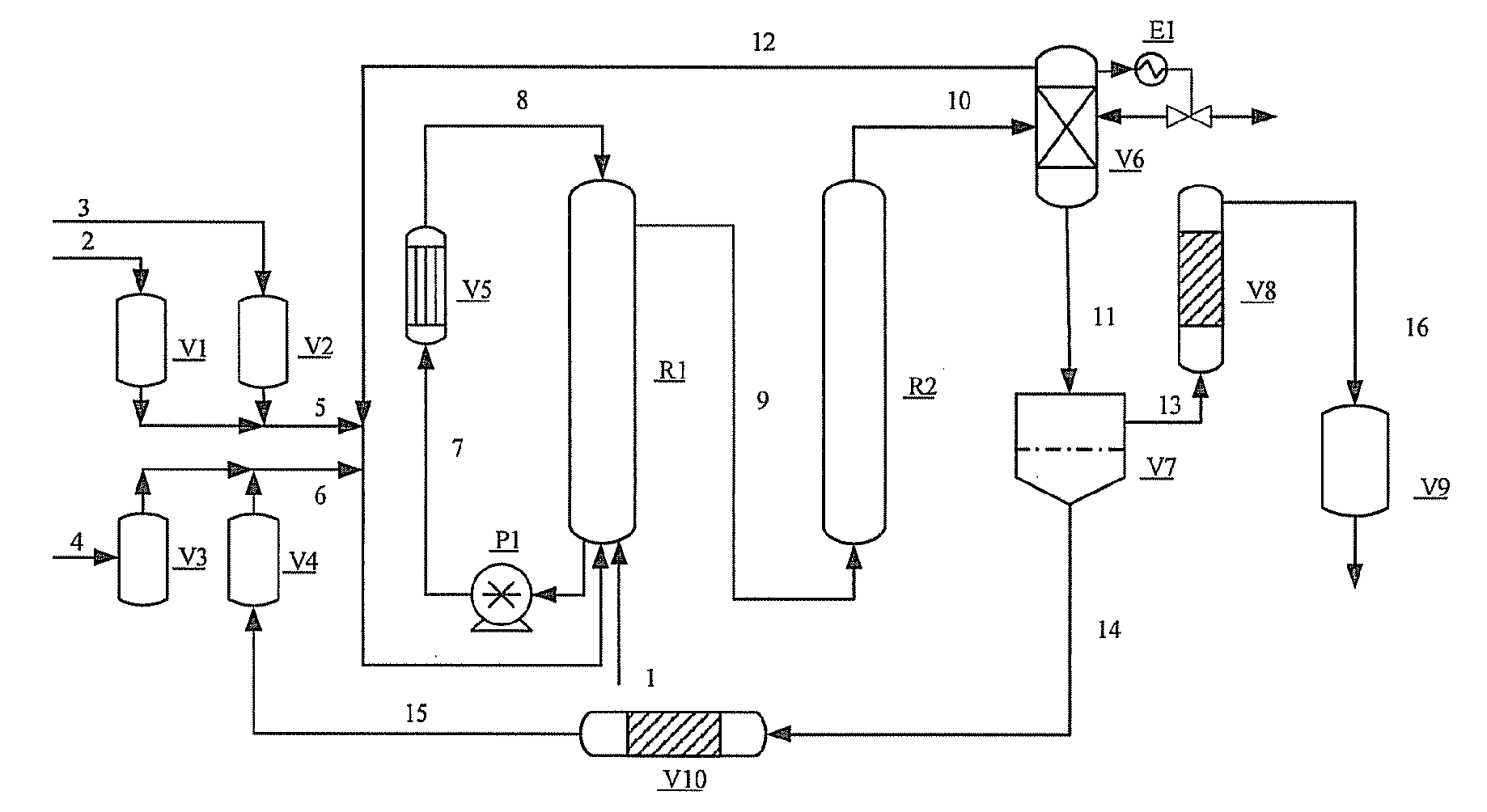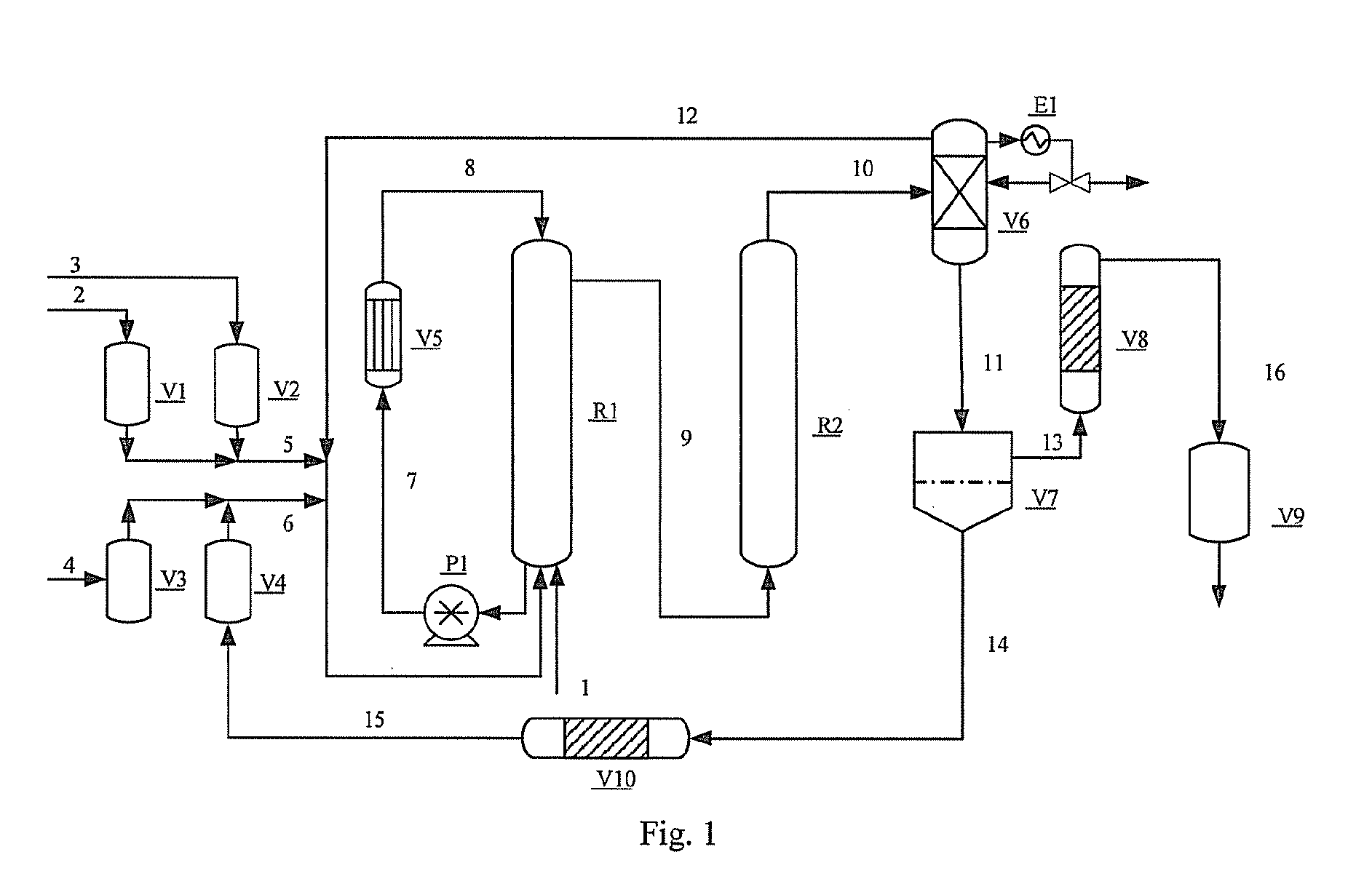Method for synthesizing polyoxymethylene dimethyl ethers catalyzed by an ionic liquid
a technology of ionic liquid and polyoxymethylene dimethyl ether, which is applied in the preparation of ethers, organic compounds/hydrides/coordination complex catalysts, physical/chemical process catalysts, etc., can solve the problems of catalysts not being recycled, complex separation process, and high energy consumption of processing
- Summary
- Abstract
- Description
- Claims
- Application Information
AI Technical Summary
Benefits of technology
Problems solved by technology
Method used
Image
Examples
example 1
[0060]In the reaction process shown in the drawing, the volumes of reactors R1 and R2 were both 500 mL. Reactor R1 and the heat exchanger were connected circularly, and a reaction liquid was circulated in the reactor and the heat exchanger.
[0061]The air in the system was replaced by purging with high purity nitrogen gas. An ionic liquid catalyst I was added into a flowing reaction system at a feeding rate of 0.8 g / min. The feeding was stopped when the catalyst solution began to circulate. The concentration of the catalyst was controlled to be not lower than 4%. Starting materials of trioxymethylene with a purity of 98.5 wt % and methanol with a purity of 99% were added at feeding rates of 11.5 mL / min and 8 mL / min, respectively. The operating conditions for reactors R1 and R2 were controlled to be 115˜120° C. and 1.0˜2.0 MPa.
[0062]The reaction liquid was introduced into film evaporator V6. A light component (comprising DMM1-2, and unreacted methanol and trioxymethylene) was separated...
example 2
[0064]The acetalation reaction was continued for 100 hours in the same manner as example 1, with the exception of adding an ionic liquid II as a catalyst. The average values of the flow rates and compositions of substances were shown in Table 2.
TABLE 2DischargingProduct Distribution (%)AnalysisRateCH3O(CH2O)nCH3 with Different n ValuesItemsmL / minMethanolTrioxymethylene12345678Light9.512.910.838.837.21.300000ComponentProduct19.01.70.20.0.237.5 23.119.4 12.43.71.8
[0065]The single-pass conversion of trioxymethylene was 92.4%.
example 3
[0066]The acetalation reaction was continued for 100 hours in the same manner as example 1 except that a single tubular reactor was used. When the feeding rate was unchanged, the residence time was reduced by 50% and the reaction conversion decreased substantially. The average values of the flow rates and compositions of substances were shown in Table 3.
TABLE 3DischargingProduct Distribution (%)AnalysisRateCH3O(CH2O)nCH3 with different n valuesItemsmL / minMethanolTOX12345678Light14.07.931.629.531.20.300000ComponentProduct18.51.00.300.638.5 22.621.4 122.61.1
[0067]The single-pass conversion of trioxymethylene was 67.2%.
PUM
| Property | Measurement | Unit |
|---|---|---|
| Temperature | aaaaa | aaaaa |
| Temperature | aaaaa | aaaaa |
| Temperature | aaaaa | aaaaa |
Abstract
Description
Claims
Application Information
 Login to View More
Login to View More - R&D
- Intellectual Property
- Life Sciences
- Materials
- Tech Scout
- Unparalleled Data Quality
- Higher Quality Content
- 60% Fewer Hallucinations
Browse by: Latest US Patents, China's latest patents, Technical Efficacy Thesaurus, Application Domain, Technology Topic, Popular Technical Reports.
© 2025 PatSnap. All rights reserved.Legal|Privacy policy|Modern Slavery Act Transparency Statement|Sitemap|About US| Contact US: help@patsnap.com



